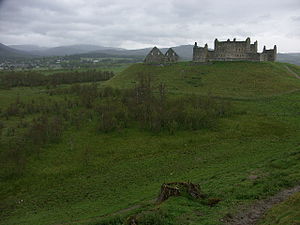Siege of Ruthven Barracks (1745)
The Siege of Ruthven Barracks by Jacobite rebels of a small group of government soldiers took place in August 1745 and was part of the Jacobite rising of 1745.[1]
| Siege of Ruthven Barracks (1745) | |||||||
|---|---|---|---|---|---|---|---|
| Part of the Jacobite rising of 1745 | |||||||
 The remains of Ruthven Barracks | |||||||
| |||||||
| Belligerents | |||||||
|
|
| ||||||
| Commanders and leaders | |||||||
|
|
| ||||||
| Strength | |||||||
| 15[2] | 150[2] | ||||||
| Casualties and losses | |||||||
| 1 killed[2] | 2 killed[2] | ||||||
Background
On 29 August 1745 a force of 300 Jacobite rebels marched on the Government held Ruthven Barracks.[2] The barracks were under the command of Sergeant Terrance Molloy who had with him only 14 private soldiers.[2] The Jacobites came to the gate of the barracks and demanded that Molloy surrender.[2] Molloy was defiant and refused despite the Jacobites telling him that they would hang him and his men if he refused.[2] The Jacobites then retreated some distance.[2][3]
The assault
At nightfall around about 150 Jacobites returned and attacked the barracks.[2] They set fire to the door gate but the defending soldiers managed to put it out.[2] The man who started the fire was spotted and became an early victim.[2] At about half past three in the morning the Jacobites withdrew.[2] Sergeant Molloy then agreed to speak to two of the Jacobite leaders but he still refused terms of surrender.[2] However, Molloy did agree to allow the Jacobites to remove their dead and wounded.[2] The Jacobites had lost two men dead and several others wounded.[2] The Government soldiers had only lost one man, who had been killed when he raised his head above the parapet, despite orders to keep his head down.[2]
Aftermath
The Jacobites then left Ruthven but not without stealing many provisions from the residents of Ruthven Village.[2] Sergeant Molloy was immediately promoted to the rank of Lieutenant.[2] On 10 February 1746, 300 Jacobites returned to attack Ruthven Barracks again and this time they had the advantage of having brought artillery with them.[2]
References
- Fremont-Barnes, Gregory (2011). The Jacobite Rebellion 1745-46. p. 41. ISBN 1846039924.
- Love, Dane (2007). "15: Over the Corrieyairack". Jacobite Stories. p. no page numbers. ISBN 1903238862.
- Kybett, Susan Maclean (1988). Bonnie Prince Charlie: A Biography. London: Unwin Hyman. p. 128. ISBN 0044402139.